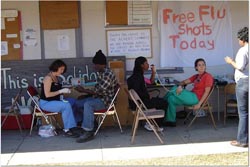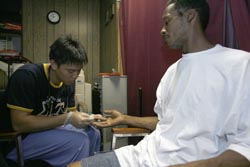Community service is alive and well at med school
Each year, hundreds of students participate in more than 60
programs around the world
| Temple medical student Zoë Maher watched the news in horror in August 2005, as Hurricane Katrina pummeled New Orleans and Baton Rouge, La., where she had been a school teacher. As she watched people suffer needlessly in the aftermath, she decided something had to be done.
After receiving $9,000 in grants from the Temple University School of Medicine Alumni Association and the Arnold P. Gold Foundation, Maher led 10 other medical students to New Orleans over their winter break in 2005 to offer medical assistance and general manpower to residents in hurricane- and flood-ravaged parts of the city. She and her classmates traveled back to the city several times after that to continue to offer aid. |
 Photo courtesy Zoe Maher
During their 2005 winter break, several Temple medical students traveled to New Orleans to work at makeshift clinics, like the one shown above, to provide medical care to residents affected by Hurricane Katrina. |
|
Maher’s need to help others is not an anomaly among the students at the School of Medicine. Each year, hundreds of students participate in more than 60 programs aimed at helping residents in North Philadelphia and beyond. That list will grow this fall, with the start of the Temple Emergency Action Corps, a student-run project based on Maher’s group’s efforts, that will train first- and second-year medical students to become first responders who will visit areas locally, nationally and internationally that have suffered natural disasters to offer medical and humanitarian help. The inaugural class will learn medical techniques such as wound care and suturing, and will also learn about psycho-social factors that victims often suffer after a traumatic ordeal. |
|
 Photo courtesy Ryan Brandenberg/Temple University
Second-year medical student Nick Tyau treats a patient at the Temple CARES clinic, a free student-run health clinic that provides medical care and health screenings on a weekly basis at a church in North Philadelphia. |
“This program is the culmination of all of the work we’ve done in New Orleans,” Maher said. “The overall goal of our trips was to help the people in Louisiana, but to also help people in other parts of the country and the world by starting this program.” Tip of the iceberg Temple medical students like Maher who share a great need to help others are helping out at programs like Temple CARES, a student-run health clinic that provides medical care and health screenings on a weekly basis at a local church; Prevention Point, an organization with which students volunteer that provides an array of health services to the underserved; and the Community Service Outreach Group, which holds an annual health fair at a local elementary school. |
|
While checking a patient’s blood pressure at the free Temple CARES clinic, second-year student Nick Tyau said that community service is just as important as learning in the classroom. “It helps us to get away from all the machines and the lectures, and really connect with the patient,” he said. Paul Lyons, associate professor of family and community medicine at the School of Medicine, who accompanied the first group of medical students to New Orleans and helped students start the Temple CARES program more than 10 years ago, said Temple simply attracts a different type of student. |
|
|
Indeed, more than half of the class of 2007 served their community in various capacities before coming to Temple, up almost 10 percent from the previous year. Most notably, the class included a victim’s advocate with the Philadelphia District Attorney’s Office, a teacher’s assistant at an alternative high school, and a biology teacher for troubled youth. Second-year student Amy Hosmer explained that she chose Temple over other medical schools specifically for its commitment to service. After being active in the community while receiving her undergraduate degree from Wake Forest, she searched for a school where she could continue to serve others. “I looked at a number of other schools, but Temple’s reputation for community service was a deciding factor for me,” she said. “There are a number of programs here that give you the freedom to decide how you want to help. You can focus on a lot of different programs, or just focus your energy on one specific project.” Tyau agreed with Hosmer, noting that he was in a similar situation. When choosing between different schools, he picked Temple for the same reasons she did. “Our students are a neat group. They have the initiative and the drive for change already inside them. The programs here simply provide our students with the proper tools they need to take action,” Lyons said. |
Other Ways to Contribute
For the students at the School of Medicine, life can be extremely hectic. For the student who wants to help the North Philadelphia community and beyond, but might not be able to dedicate as much time as they’d like, there is the Temple Volunteers Organized Against Disaster (VOAD), an organization that seeks donations for the less fortunate. After Hurricane Katrina, Temple’s VOAD answered the call from the Louisiana AssistiveTechnology Access Network for critically needed durable medical equipment. As a result of Temple’s response, two full trailers of supplies, including wheelchairs and IV stands, were sent to residents in the areas affected by Hurricane Katrina. “Temple has a great reputation for community service,” said George Heake, emergency management coordinator at the Institute on Disabilities and director of special operations at the Center for Preparedness, Research and Education at the College of Health Professions. “Students and faculty put their feet flat on the ground and run with these types of programs. That’s what gave me the idea for VOAD.” Going forward, Temple VOAD seeks to build a permanent program in order to plan ahead for times of emergency or disaster. Through student volunteers, as well as faculty and staff involvement, Temple VOAD can continue to collect much-needed supplies for those in need. “It is truly amazing the response we have received and continue to receive from the Temple community,” Heake said. |
|
Tools like real-life experience, which Maher and her classmates were able to get from their numerous trips to Louisiana. “It’s important for all medical students to be exposed to the type of environment that we were. It allows you to be empathetic to the needs of the patient,” said Maher. “You can study similar situations in school, but the human element is really the best way to learn and understand what people are going through.” Temple’s medical students have a strong presence in the North Philadelphia community, and a new movement is growing to extend that presence into other parts of the country and the world. Over the past five years, students have traveled to more than 20 countries on five continents to complete international rotations and to volunteer with organizations such as Habitat for Humanity and Doctors without Borders. Students involved in the International Health Organization seek to bolster global healthcare based on their collective belief that anyone, regardless of location, should have access to basic healthcare. This summer, a group of six medical students traveled to Tanzania to provide medical supplies to a clinic in rural Karatu and discussed with local citizens the healthcare needs of the community. "We didn't want to go over empty handed, so the hospital was gracious enough to donate a number of medical supplies for this trip," said Jennifer Jou, a second-year medical student, adding that the trip was part of a larger effort to establish a permanent site for Temple medical students to continue to visit and gain experience during the summer after their first year and as an elective rotation during the fourth year. Another goal is to bring Temple physicians and residents along with students on future trips. “We hope to gain enough information on this first trip to educate fellow students who have an interest in global medicine,” said second-year medical student and trip co-coordinator Rachel Altork. “We’d like to return each year to focus on a new area of need.” In addition to this program, fourth-year student Monica Dhand and fellow students traveled to El Salvador in June to volunteer at a free health clinic. Other students traveled to Venezuela to provide healthcare services and volunteer with Habitat for Humanity. Many of the students, including those who went to Tanzania, fund the trips themselves. While international health programs have long existed at Temple on an unofficial basis, “there is definitely a push to start an organized system where students can get information about volunteering abroad,” Lyons said. “Programs like these help the students gain a tremendous amount of experience. They get to be doctors before actually becoming doctors. Our students are committed to helping others, and I think there’s very little that will lessen that drive.” |
|